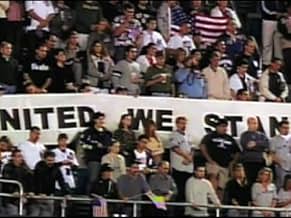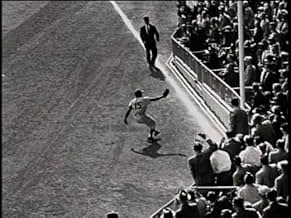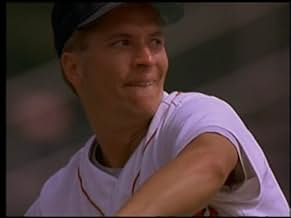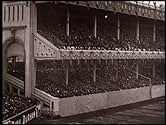Un documental sobre la historia del deporte con temas importantes como los jugadores afroamericanos, las relaciones entre jugadores y propietarios de equipos y la resistencia del juego.Un documental sobre la historia del deporte con temas importantes como los jugadores afroamericanos, las relaciones entre jugadores y propietarios de equipos y la resistencia del juego.Un documental sobre la historia del deporte con temas importantes como los jugadores afroamericanos, las relaciones entre jugadores y propietarios de equipos y la resistencia del juego.
- Ganó 1 premio Primetime Emmy
- 3 premios ganados y 5 nominaciones en total
Opiniones destacadas
However, there is a major flaw in the series - especially the later parts - its very evident New York bias. The people being interviewed, aside from former players, all seem to be New Yorkers. In the segment about the Dodgers and Giants moving west, for example, we are repeatedly told how it was a horrible tragedy for the teams to leave New York, but it's barely mentioned that, before those teams left, New York was barely supporting them, or that, while New York had three major league teams, the entire western half of the United States had none. And while some attention was payed to the post-move Dodgers (specifically Sandy Koufax), the episode on the 60s pretty much ignored the post-move Giants, even though their teams included several future Hall of Famers, including Willie Mays, Willie McCovey, Juan Marichal, Orlando Cepeda, and Gaylord Perry. I'm sure other teams were similarly overlooked in favor of the Yankees and Red Sox, but as a Giants fan, that especially stood out for me.
The music is pitch perfect. Burns sticks with an Americana theme for his soundtrack. Variations on "Take Me Out to the Ballgame" and "The Star-Spangled Banner" provide the primary background music. They are joined by a number of classic baseball songs and tunes that defined generations. The music puts you in the era and adds to the simultaneous definitions of the game and the country.
The storytelling style was a bit jilting at first. Each inning is told in segments. A title pops up on the screen, and then that story is related. At the end of that segment, a postscript is added that may or may not have anything to do with the preceding tale. Initially that was disorienting, but once one realizes how the doc is going to work, it's no longer bothersome.
Ken Burns' defining technique is his use of still pictures, panning and zooming over and around them in a fashion that nearly brings them to life. Accompanied by various ballpark sound effects, that style is perfect for the game of baseball. The deliberate pace of the documentary matches the deliberate pace of the game. But most remarkable about "Baseball" is the archival footage. Antique film of early century heroes like Ty Cobb and Babe Ruth literally caused my jaw to drop at times. I had no idea such video existed, and seeing all the classic footage for the first time is like being introduced to a whole new ballgame and cast of characters. Oddly enough, the entire film works better before colorized film and photos are introduced. Perhaps because of the romantic nature of monochromatic hues. Perhaps because they seem new and fresh when compared to the colors we are bombarded with today. Whatever the reason, the first two-thirds of "Baseball" stand out, due in part to the simple yet elegant pictures.
Aside from the archival footage, the highlights of the documentary were not the historical accounts themselves, but rather the commentary by various people who expound upon the intricacies of baseball. Bob Costas reminds us that baseball is a beautiful game. Robert Creamer explains the social aspect of baseball. Billy Crystal tells of his wide-eyed attitude as a youngster. Moments like these will bring a smile to your face, as you nod your head enthusiastically in agreement.
Through the 1950s, Burns covers everything I could think of, along with many great tangents. A major theme to that point is race, as Burns consistently makes a point to explain how baseball is not just a game but also a social barometer. Side stories such as the history of the ballpark frank and "Take Me Out to the Ballgame" provide the documentary with a well-roundedness that appeals to people besides the hard-core baseball fan.
My only complaint about this piece of work is a common one. A little too much Northeast bias once the series hit the 1960s. Up to that point, I didn't notice much, probably because baseball did more or less revolve around New York and Boston until expansion. But since the 1960s, the game has truly become national, even international, and I feel that the documentary didn't quite reflect that. Admittedly, the expansion of the game made it more difficult to cover all that has happened in the last quarter century. Also, part of the reason I felt shortchanged was undoubtedly because I am familiar with a larger number of recent events and knew more about what was absent. I realize that with the final 25 years crammed into one two hour episode, many great events had to be truncated or eliminated, but I was still left mildly disappointed.
Like the players that participated in the game it describes, this mini-series is not perfect. However, to maintain the baseball analogy, Ken Burns' documentary is both Hank Aaron and Roger Maris...er, Barry Bonds. It has phenomenal singular moments and also has the longevity to attain Hall of Fame status.
Bottom Line: The scope of "Baseball" combines with the dead-on moments to present a near perfect history and explanation of why baseball is the greatest game ever. 10 of 10.
Inning 1 (Our Game) - 1840s-1900. This segment reveals some facts probably 98 percent of all fans don't know, such as Abner Doubleday did NOT invent the game baseball, that it slowly evolved from a combination of rounders and cricket.
Inning 2 (Something Like A War) - 1900-1910. This might have been the most interesting tape (or disc) featuring incredible stories of riots on the field, in the stands, a stadium and 13 adjacent building all catching fire, one wild story after another. It's the era of the most hated player in the history of the game: Ty Cobb.
Inning 3 (The Faith Of 50 Million People) - 1910-1920. Almost as good as the previous decade. this was a time when America went absolutely batty over baseball. The players were the toughest they have ever been, playing for horrible wages where the game was "life and death" for many. The last half hour centers on the famous Black Sox Scandal.
Inning 4 (A National Heirloom) 1920-1930. This tape centers primarily on Babe Ruth, but who's complaining? Ruth was arguably the greatest player the game has ever known because he could pitch and well as he could hit and was an extremely colorful personality.
Inning 5 (Shadow Ball) 1930-1940. This segment revolves around the beginnings of the Negro Leagues as perhaps the game's greatest pitcher ever: Leory "Satchel" Paige.
Inning 6 (The National Pastime) 1940-1950. Baseball was now open to all people as Jackie Robinson breaks the color barrier. Being Liberal-bias, Burns went overboard on this - and similar topics throughout the series - but Robinson's entry, nonetheless, was the biggest change in the history of the sport and he was an incredible man.
Innning 7 (The Capital Of Baseball) - 1950-1960. This tape is definitely for New York City area fans, but the rest of us can enjoy a lot of this, too. The Yankees, Dodgers and Giants all dominated in this decade.
Inning 8 (A Whole New Ballgame) - 1960-1970. Being a decade of social upheaval, riots, assassinations, etc., this centers on the effect on baseball and with the big change in owner-player relations with the players hiring Marvin Miller, a labor lawyer, to represent them.
Inning 9 (Home) - 1970-time of film release. This is potpourri of items from Earl Weaver and the Orioles to Willie Stargell and the Pirates and The Big Red Machine, the Red Sox horrible defeat in the 1986 World Series, among other things.
It would be interesting to see this updated and revised to include the strike in the mid '90s, the home run record-breakers and subsequent steroids scandal and, yes, the Red Sox finally winning it all.
¿Sabías que…?
- TriviaIronically, first aired in the fall of 1994 when much of the season and the World Series were cancelled due to a strike. This made it the only "baseball" available to millions of unhappy fans at what should have been the most exciting time of the season.
- Citas
Narrator: It is played everywhere. In parks and playgrounds and prison yards. In back alleys and farmers' fields. By small children and old men. Raw amateurs and millionaire professionals. It is a leisurely game that demands blinding speed. The only game in which the defense has the ball. It follows the seasons, beginning each year with the fond expectancy of springtime, and ending with the hard facts of autumn. It is a haunted game, in which every player is measured against the ghosts of all who have gone before. Most of all, it is about time and timelessness. Speed and grace. Failure and loss. Imperishable hope. And coming home.
- ConexionesFeatured in WatchMojo: Top 10 Documentary Mini Series (2015)
Selecciones populares
- How many seasons does Baseball have?Con tecnología de Alexa
Detalles
- Tiempo de ejecución1 hora 44 minutos
- Color
- Mezcla de sonido
- Relación de aspecto
- 16:9 HD
- 4:3
Contribuir a esta página



































